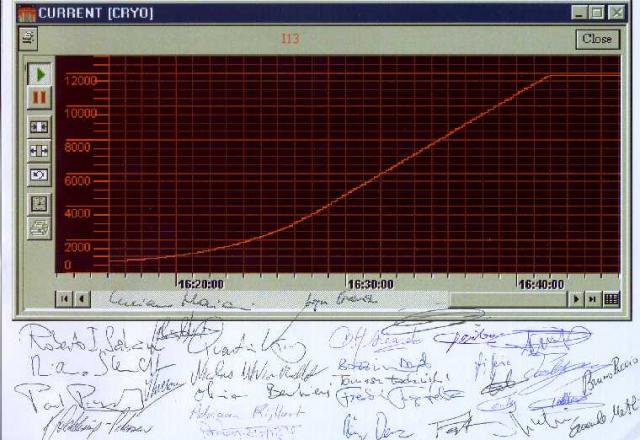Geneva, 2 October 2001. It was all systems go for CERN1's forthcoming particle accelerator, the Large Hadron Collider (LHC), last week when a chain of prototype magnets was successfully operated for the first time at the full magnetic field needed to achieve the high energy of the LHC's particle beams. Known as String 2, the chain consists five superconducting magnets along with all the necessary cooling, powering, and safety systems. Its successful operation is a clear indication that the Laboratory is firmly on course to meet the LHC's exacting technical requirements.
Geneva, 2 October 2001. It was all systems go for CERN1's forthcoming particle accelerator, the Large Hadron Collider (LHC), last week when a chain of prototype magnets was successfully operated for the first time at the full magnetic field needed to achieve the high energy of the LHC's particle beams. Known as String 2, the chain consists five superconducting magnets along with all the necessary cooling, powering, and safety systems. Its successful operation is a clear indication that the Laboratory is firmly on course to meet the LHC's exacting technical requirements.
When the LHC starts up in just five year's time, it will be the world's largest superconducting installation of any kind. Nearly all of its main magnets, some 2000 in total, will be bathed in liquid helium at 1.9 Kelvin (around 300 degrees centigrade below room temperature). Such a low temperature is required to keep the magnets superconducting, but maintaining it presents many challenges. The cold-mass of each magnet is installed inside a vacuum vessel and rests on high-tech composite feet that are actively cooled from room temperature to 1.9 K over just 25 centimetres. A similar active cooling scheme is used for the cables that monitor the magnets.
String 2, as its name suggests, is the second LHC systems test bed. It is also the first to be built to the LHCÕs final design, and the last chance for LHC engineers to validate their design choices before installation of the new accelerator underground. In its current configuration, String 2 consists of three prototype dipole magnets, two quadrupoles, and a full-scale prototype distribution line for the cryogenic fluids that cool the magnets. Fifteen electrical powering circuits, complete with final-design power converters, and a digital current regulation system capable of measuring magnet currents to a few parts per million complete the String 2 set-up.
The first stage in starting up String 2 was cooldown, which was successfully achieved two weeks ago. Then came the powering of the dipole circuit. The LHC's superconducting magnets are sensitive devices. If any part of their cable winding heats up, it provokes what is known as a quench - the magnet ceases to superconduct and the energy stored inside it has to be dissipated.
Testing the systems that detect quenches and protect the magnets is an important part of the String Team's task, and has been carried out over the last two weeks for the dipole circuit. Last Thursday afternoon 27 September at 16:00, however, all eyes were on the screen showing the magnet current rise. Everyone wanted to see the current reach 11850 Amps, which corresponds to the LHC's operational magnetic field, without a quench. They didn't have long to wait. After just 20 minutes, the dipole circuit was running smoothly.
A full programme of system validation tests is now underway in which the quadrupole circuit will be powered up and the entire String put through its paces. All systems will be tested in normal running conditions, during the ramping up and down of the magnet currents, and during provoked quenches. Later this year, three more dipoles will be added, turning String 2 into a full cell of the LHC accelerator.
1. CERN, the European Organization for Nuclear Research, has its headquarters in Geneva. At present, its Member States are Austria, Belgium, Bulgaria, the Czech Republic, Denmark, Finland, France, Germany, Greece, Hungary, Italy, Netherlands, Norway, Poland, Portugal, Slovakia, Spain, Sweden, Switzerland and the United Kingdom. Israel, Japan, the Russian Federation, the United States of America, Turkey, the European Commission and Unesco have observer status.
